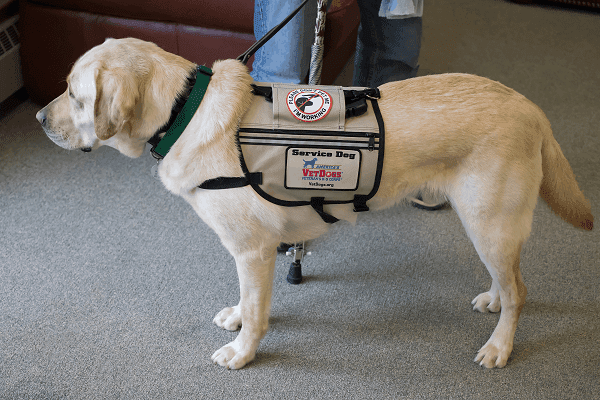We’ve all seen the dog in the restaurant hanging out in his/her owners lap. Most of us query, is this legal? Is this a service animal or something else?
1. service
2. support
 Service animal
Service animal
A service animal is an animal trained to perform tasks for a person with a physical, sensory, psychiatric, intellectual, or other mental disability. Service animals are considered working animals, not pets. For example, seeing-eye dogs are service animals. They perform specific trained tasks that mitigate the individual’s disability.
Aside from miniature ponies, almost all service animals are dogs. Examples of tasks performed by service animals include assisting those who are visually or hearing impaired people, helping pull a wheelchair, retrieving items such as medicines or cell phones, recognizing and assisting people with seizures, alerting to a specific metabolic shift (e.g., hypoglycemia), or interrupting people suffering from compulsive or destructive behavior disorders.
Service dogs are not: Emotional Support Dogs!
One gray area to some folks may be psychiatric service dogs (PSD), which are viewed as working animals and have been trained to perform specific trained tasks to assist people with emotional or psychiatric disabilities severe enough to substantially limit the person’s ability to perform at least one major life task. For example, people with Post-Traumatic Stress Disorder who have difficulty coping with loud noises, or suffer from agoraphobia, might be able to use a PSD to help overcome or cope with these psychological issues.
Emotional support animals
Emotional support animals (ESA) are not trained for any specific task to assist people with any disabilities. They
are not recognized as service (working) animals, but as pets that have additional value by providing emotional support and/or therapeutic benefit to a person with a verifiable mental or psychiatric disability. There are no species, size, or weight restrictions or guidelines for ESA – feasibly, these could be anything from a rabbit, snake, or ferret to a horse, as permitted by state laws.
Comparison of Service Animal and Emotional Support Animal Characteristics and Regulations.
|
Service Animals |
Emotional Support Animals |
| Definition |
Individually trained to do work or perform tasks to mitigate the disability of an individual with a disability, including a physical, sensory, psychiatric, intellectual, or other mental disability. |
Provide necessary emotional support to individuals with disabilities and alleviate one or more identified symptoms of a person’s disability. |
| Disability |
Individuals with disabilities are defined as persons with a physical or mental impairment which substantially limits one or more major life activities. |
Individuals with disabilities are defined as persons with a physical or mental impairment which substantially limits one or more major life activities. |
| What can be asked |
Is this a service animal? What service/skill/task does the animal do? |
The person might be requested to submit a letter from a mental health professional that addresses the question as to how the emotional support animal alleviates symptoms associated with their disability. |
| Type |
Dog or minature horse. |
Any species of animal that is permitted under state law and local ordinances. |
| Training |
Trained to perform tasks for the benefit of an individual with a disability and to behave appropriately in public (unless they are for in-home service only). |
None required |
| Where permmitted |
All places of public accommodation — government buildings, public buildings, restaurants, taxis, public transit, etc. (Not private residences, not churches, not medical areas where public is not allowed) |
Residence halls
Classrooms — case-by-case basis determination
Certain housing rentals, public housing
Airplanes (possibly trains) |
| Regulations |
Must be under effective control at all times
Follow all state laws and local ordinances |
Must be under effective control at all times
Follow all state laws and local ordinances |
How does US law treat these different animals?
Both service animals and PSD are covered by the ADA (Americans with Disabilities Act 2010). Under the ADA state and local governments, businesses and nonprofit organizations that serve the public must allow service animals to accompany people with disabilities in all areas of the facility where the public are allowed
On the other hand, there are no laws restricting species, size, or weight of an animal  considered an ESA. The Department of Housing and Urban Development (HUD) views ESAs similar to other aids, such as wheelchairs, that provide a person with a disability an equal opportunity to live independently. However, the ADA does not consider the need for an ESA as a disability that warrants special accommodations. So, ESAs are only protected in airports (including airplanes under TSA rules not the ADA), and certain housing situations (under Fair Housing Amendments Act of 1988 not the ADA), e.g. residence halls, rental housing, public housing. ESAs have no rights to public access.
considered an ESA. The Department of Housing and Urban Development (HUD) views ESAs similar to other aids, such as wheelchairs, that provide a person with a disability an equal opportunity to live independently. However, the ADA does not consider the need for an ESA as a disability that warrants special accommodations. So, ESAs are only protected in airports (including airplanes under TSA rules not the ADA), and certain housing situations (under Fair Housing Amendments Act of 1988 not the ADA), e.g. residence halls, rental housing, public housing. ESAs have no rights to public access.
Can I ask a person if an animal is a service animal or ESA?
Sort of. You can ask if an animal is a service animal required because of a disability. You can also ask what task the service animal has been trained to perform. If an animal is NOT trained for a specific task or set of tasks, you should assume that this animal is an ESA or pet.
What can I NOT ask?
You cannot ask what disability the animal owner has. You cannot ask to see the task demonstrated. You cannot ask to see documentation.
So, that person with the pooch sitting in the restaurant may have an ADA-recognized disability and lawfully be allowed or it may not. While the restaurant owner can ask if the dog is a service animal and what specific task it can perform, the restaurant owner cannot make the owner provide documentation or ask to see the related task being performed, so therein lies the murky areas.
 Service animal
Service animal considered an ESA. The Department of Housing and Urban Development (HUD) views ESAs similar to other aids, such as wheelchairs, that provide a person with a disability an equal opportunity to live independently. However, the ADA does not consider the need for an ESA as a disability that warrants special accommodations. So, ESAs are only protected in airports (including airplanes under TSA rules not the ADA), and certain housing situations (under Fair Housing Amendments Act of 1988 not the ADA), e.g. residence halls, rental housing, public housing. ESAs have no rights to public access.
considered an ESA. The Department of Housing and Urban Development (HUD) views ESAs similar to other aids, such as wheelchairs, that provide a person with a disability an equal opportunity to live independently. However, the ADA does not consider the need for an ESA as a disability that warrants special accommodations. So, ESAs are only protected in airports (including airplanes under TSA rules not the ADA), and certain housing situations (under Fair Housing Amendments Act of 1988 not the ADA), e.g. residence halls, rental housing, public housing. ESAs have no rights to public access.

